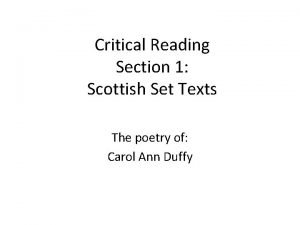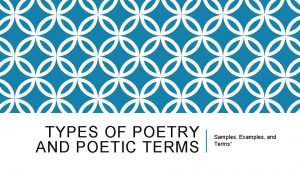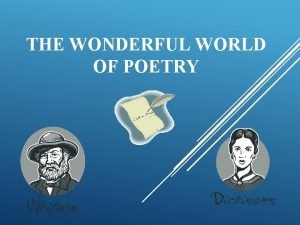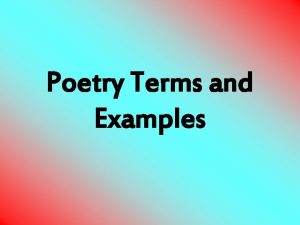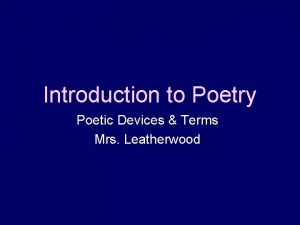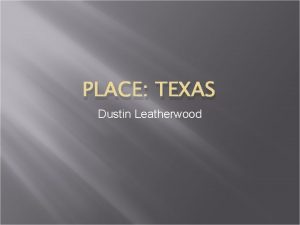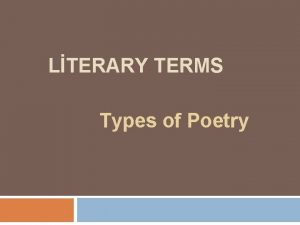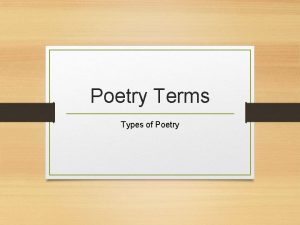English I Poetry Terms Mrs Leatherwood Poetry Terms









- Slides: 9

English I Poetry Terms Mrs. Leatherwood

Poetry Terms • Alliteration The repetition of the same or similar sounds at the beginning of words such as tongue twisters like 'She sells seashells by the seashore' • Assonance The repetition or a pattern of similar sounds, as in the tongue twister "Moses supposes his toeses are roses. “ • Atmosphere The emotional tone (for instance, joy, or horror) in a work, most often established by the setting. The atmosphere is "an air that the characters breathe, a world in which they move. "

• Blank Verse Poetry that is written in unrhymed iambic pentameter. Blank verse is often unobtrusive and the iambic pentameter form often resembles the rhythms of ordinary speech. Shakespeare wrote most of his plays in blank verse. • Free Verse Poetry composed of either rhymed or unrhymed lines that have no set fixed metrical pattern or expectation. • Iambic Pentameter Shakespeare's plays were written mostly in iambic pentameter, which is the most common type of meter in English poetry. It is a basic measure of English poetry, five iambic feet in each line.

• Imagery draws the reader into poetic experiences by touching on the images and senses which the reader already knows. • Meters are regularized rhythms. An arrangement of language in which the accents occur at apparently equal intervals in time. Each repeated unit of meter is called a foot. • Rhyme The occurrence of the same or similar sounds at the end of two or more words.

• • Rhythm is significant in poetry because poetry is so emotionally charged and intense. Rhythm can be measured in terms of heavily stressed to less stressed syllables. Rhythm is measured in feet, units usually consisting of one heavily accented syllable and one or more lightly accented syllable. Stanza Two or more lines of poetry that together form one of the divisions of a poem. The stanzas of a poem are usually of the same length and follow the same pattern of meter and rhyme.

• Symbol An object, character, figure, or color that is used to represent an abstract idea or concept. For example, the two roads in Robert Frost’s poem “The Road Not Taken” symbolize the choice between two paths in life. • Theme A major idea that the poem illustrates or circle around consistently. • Tone The implied attitude of a writer toward the subject and characters of a work, as, for example, Flannery O'Connor's ironic tone in her "Good Country People. "

Figurative Language • Metaphor A metaphor is a pattern equating two seemingly unlike objects. An examples of a metaphor is 'drowning in debt'. • Simile A figure of speech in which two things are compared using the word "like" or "as" to draw attention to similarities about two things that are seemingly dissimilar. • Onomatopoeia A figure of speech in which words are used to imitate sounds. Examples of onomatopoeic words can be found in numerous Nursery Rhymes e. g. clippety-clop and cock-a-doodle-do. • Personification means giving human traits to nonhuman or abstract things.

Types of Poems • Ballad A poem that tells a story similar to a folk tale or legend and often has a repeated refrain. • Couplet A couplet has rhyming stanzas each made up of two lines. Shakespearean sonnets usually end in a couplet. • Epic A long, serious poem that tells the story of a heroic figure. Two of the most famous epic poems are the Iliad and the Odyssey by Homer and the epic poem of Hiawatha. • Haiku A Japanese poem composed of three unrhymed lines of five, seven, and five syllables. Haiku reflects on some aspect of nature.

• Lyric Poetry A poem, such as a sonnet or an ode, that expresses the thoughts and feelings of the poet. The term lyric is now generally referred to as the words to a song. • Soliloquy A dramatic convention by means of which a character, alone onstage, utters his or her thoughts aloud. • Sonnet English (or Shakespearean) sonnets are lyric poems that are 14 lines long falling into three coordinate quatrains and a concluding couplet.
 They are mrs garcia and mrs castro
They are mrs garcia and mrs castro They are mrs garcia and mrs castro
They are mrs garcia and mrs castro Mrs. darling was ___________ of mrs. s.
Mrs. darling was ___________ of mrs. s. What inspired carol ann duffy to write war photographer
What inspired carol ann duffy to write war photographer In mrs tilscher's class analysis higher english
In mrs tilscher's class analysis higher english Like terms and unlike terms in polynomials
Like terms and unlike terms in polynomials Like terms in algebra
Like terms in algebra Examples of poetry terms
Examples of poetry terms Formal division of lines in a poem, considered as a unit.
Formal division of lines in a poem, considered as a unit. Eight balloons poem
Eight balloons poem



